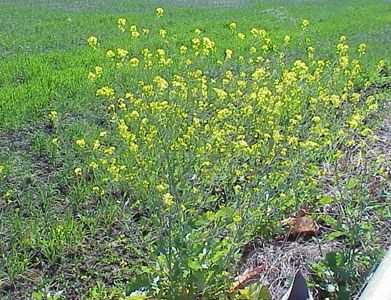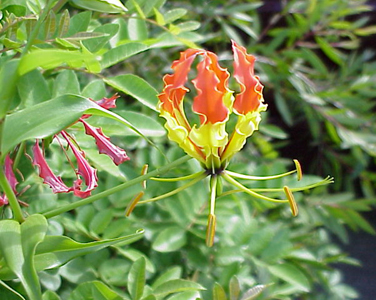Weed-free seed
Planting crop seed contaminated with weed seed is one of the most common ways of introducing weeds into crop land. Clean, tested and tagged crop seed has
much fewer weed seeds. The type and percentage of weed seeds present in commercial crop seed is listed on the tag on the seed bag,
and is based on a representative sample.
Crop rotations
Rotations are practiced as a means of weed control to prevent or reduce
the build up of high populations of weeds common to a particular crop. The
kind of crop plants to include in a crop rotation sequence should have
growth and cultural characteristics in sharp contrast to those of the
previous crop and the problem weed. Fallow periods may also be used.
Clean tillage and harvest implements
All tillage and harvest implements should be cleaned before moving to
the next field to prevent transfer of weeds.
|

Weeds growing along fences need to be
controlled to
prevent re-infestation of cultivation.
|
Sanitation measures
This involves weed control in waste areas, on roadsides and along fences to
ensure re-infestation does not come from these sources.
Prevention of seed production
This is a common method of preventive weed control and may include mowing before weeds shed pollen or the use of fire to destroy some types of seeds.
Smother crops (live mulch)
These are crops that are especially highly competitive with the weed
species infesting an area and compete with the weed for light, nutrients
and moisture. Crops most used include barley, millet, rye, sorghum,
alfalfa, clovers, cowpeas, buckwheat, sesbania, peanuts and Sudan grass.
Controlled movement of vehicles
Most vehicles can carry weed seeds in many places, or seeds can blow from
loaded trucks without tarps.
Controlled movement of stock
Seed can be transported within the digestive tract of many animals.
Domestic animals can be ranked from most to least destructive of weed
seeds as follows: chickens, sheep, horses, swine, cattle.
|

Glory lily (Gloriosa suberba) is an
exotic plant that
has escaped from cultivation into the natural
environment.
|
Controlled movement of plants locally
Weeds should not be hauled in with sod for lawns, with potted plants,
or in irrigation water from ditches. Quarantine laws may prevent this sort of plant movement.
Controlled movement of plants internationally
Exotic plants should not be cultivated if there is a chance of their
escape into the natural environment. Quarantine laws are often in place to
prevent this.
Mechanical harvesting
Mechanical harvesting methods often scatter weed seeds over a field as
well as into new fields.
Animal feed
Animal feed may carry numerous weed seeds, however seed viability can
be destroyed by processing the feed. For example large seeds can be killed
by grinding while small seeds can be cooked. Ensilage will also destroy
most weed seeds. Composting can destroy some weed seeds but this depends
on the size of pile, type of manure, moisture content, temperature,
location and condition of weed seeds, and length of storage. |

